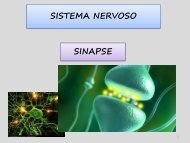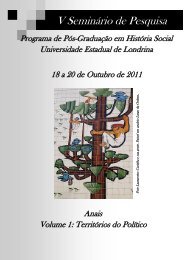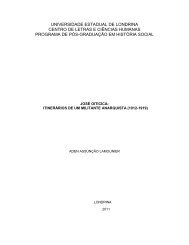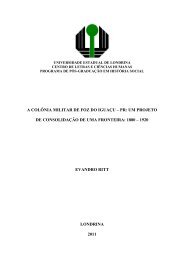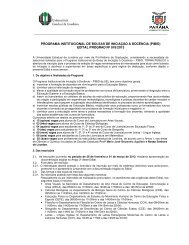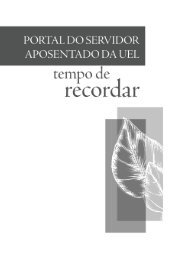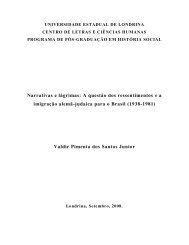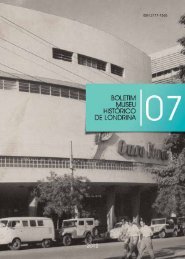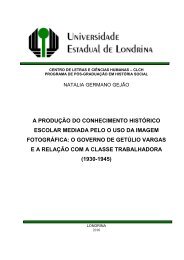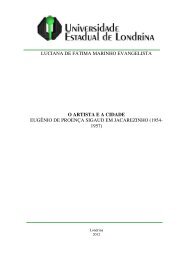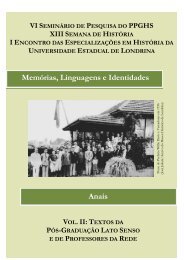DETERMINATION OF SiC CERAMIC FOAMS MICROSTRUCTURE ...
DETERMINATION OF SiC CERAMIC FOAMS MICROSTRUCTURE ...
DETERMINATION OF SiC CERAMIC FOAMS MICROSTRUCTURE ...
Create successful ePaper yourself
Turn your PDF publications into a flip-book with our unique Google optimized e-Paper software.
2009 International Nuclear Atlantic Conference - INAC 2009<br />
Rio de Janeiro,RJ, Brazil, September27 to October 2, 2009<br />
ASSOCIAÇÃO BRASILEIRA DE ENERGIA NUCLEAR - ABEN<br />
ISBN: 978-85-99141-03-8<br />
<strong>DETERMINATION</strong> <strong>OF</strong> <strong>SiC</strong> <strong>CERAMIC</strong> <strong>FOAMS</strong> <strong>MICROSTRUCTURE</strong><br />
PROPERTIES BY X-RAYS MICROTOMOGRAPHY<br />
Rodrigo Nagata, Carlos Roberto Appoloni and Jaquiel Salvi Fernandes<br />
Laboratório de Física Nuclear Aplicada – Departamento de Física<br />
Universidade Estadual de Londrina<br />
Caixa Postal 6001<br />
86051-990 Londrina, PR<br />
rodrigo_nagata@yahoo.com.br<br />
appoloni@uel.br<br />
jaquielfernandes@yahoo.com.br<br />
ABSTRACT<br />
Silicon carbide ceramic foams (<strong>SiC</strong>) can operate at high temperatures, which allow them to be used as heat<br />
exchangers, liquid metal filters, composite of rocket nozzles, etc. For many of these applications it is very<br />
important to know the foams’ porosity. In this work the porosity of <strong>SiC</strong> ceramic foams was determined by X-<br />
rays microtomography, a powerful non-destructive technique that allows the analysis of the sample’s internal<br />
structure. The samples have pore densities of 30, 45, 60, 80 and 100 pores per inch (ppi). The spatial resolution<br />
obtained was 24.8 µm. The cross sections’ reconstruction was performed with a cone beam filtered<br />
backprojection algorithm. In the analyses, micropores were observed in the foam’s lattice wire of the 30 ppi and<br />
45 ppi samples. Micropores were present in few cross sections of 60 ppi sample too, but it was not found in the<br />
80 ppi and 100 ppi samples. The total porosities obtained were Φ= (88.8 ± 4.3) %, Φ = (85.2 ± 1.4) %, Φ =<br />
(82.3 ± 1.8) %, Φ = (79.9 ± 1.3) % and Φ = (80.4 ± 1.5) %, for the 30, 45, 60, 80 and 100 ppi samples,<br />
respectively.<br />
1. INTRODUCTION<br />
Ceramic foams are open-celled structures of an interconnected lattice of ceramic bonds.<br />
Silicon carbide ceramic foams (<strong>SiC</strong>) can operate at high temperatures, which allow them to be<br />
used as heat exchangers, liquid metal filters, composite of rocket nozzles, etc [1]. For many of<br />
these applications, knowing the foams’ internal characteristics, like porosity, is very<br />
important.<br />
Porosity is defined as the fraction of empty volume found within a given sample.<br />
Conventional techniques, like Archimedes’ method or mercury intrusion porosimetry,<br />
measure the porosity, but make it impossible for sample to be used again. For this reason<br />
these techniques have been replaced by nondestructive techniques, like gamma-ray<br />
transmission or X-ray microtomography (μ-CT).<br />
Rocha [2] analyzed the internal structures of <strong>SiC</strong> ceramic foams utilizing gamma-ray<br />
transmission and X-ray microtomography techniques at 32 µm resolution. Bourne [3] used the<br />
X-ray microtomography to analyze impact tests in aluminum ceramic foams. Trater [4] used<br />
the X-ray microtomography to characterize the microstructures of biopolymers’ foams.<br />
In this work the internal structure of <strong>SiC</strong> ceramic foams was analyzed by X-ray<br />
microtomography at a resolution of 24.8 µm.
2. X-RAYS COMPUTED MICROTOMOGRAPHY<br />
Computerized X-ray microtomography (µ-CT) is a nondestructive technique that analyses the<br />
sample’s internal structure. It is based on an X-ray beam that crosses the sample and is<br />
attenuated. The sample is rotated 180º or 360º to measure attenuations at different angles. A<br />
reconstruction algorithm is then used to generate cross-sections of the sample’s internal<br />
structure. The most utilized algorithms are easily found in the literature [5,6]. The cross<br />
sections can be analyzed with specific softwares or used to carry out tridimensional<br />
reconstruction of the sample. Fig. 1 shows the general array of a microtomographic system,<br />
composed of an X-ray source, a rotation system and a detection system.<br />
Figure 1. General microtomographic array.<br />
3. EXPERIMENTAL PROCEDURE<br />
Five <strong>SiC</strong> ceramic foam samples, all produced by Erg Aerospace Company, were used in this<br />
work. The respective pore densities of the samples are as follows: 30, 45, 60, 80 and 100<br />
pores per inch (ppi). Fig. 2 shows pictures of 45 ppi and 80 ppi samples.<br />
Figure 2. 45 ppi and 80 ppi samples<br />
INAC 2009, Rio de Janeiro, RJ, Brazil.
The measurements were performed at Petrobras Research Center (CENPES), located in Rio<br />
de Janeiro, Brazil. A Skyscan Company microtomograph, model 1172, operated at 50 kV<br />
high tension and 200 µA current was utilized. The samples were rotate on 180º with a 0.25º<br />
angular pass. The spatial resolution obtained was 24.8 µm and the mean measurement time<br />
was 30 minutes for each sample. 461 cross sections of each sample were reconstructed with a<br />
cone beam filtered backprojection algorithm [6], with the exception of the 60 ppi sample, for<br />
which only 401 cross sections were reconstructed.<br />
One of main difficulties in the microtomographic images analyses is image segmentation.<br />
Techniques which aim at optimizing image segmentation can be found in the literature [7,8].<br />
In this work the most common method for image segmentation was used. It consists in<br />
visually choosing a unique threshold value for the gray level in order to binarize the image.<br />
The images were binarized and analyzed using the Imago software, developed by ESSS<br />
Company, in order to obtain the porosity of each cross section. The total porosity was<br />
obtained by averaging the porosity of all the cross sections.<br />
4. RESULTS<br />
Table 1 shows the binarization thresholds for each sample and Fig. 3 shows the comparison<br />
between original image and binarized image.<br />
Table 1. Binarization threshold for each sample<br />
Sample<br />
Threshold<br />
30 ppi 104<br />
45 ppi 104<br />
60 ppi 74<br />
80 ppi 63<br />
100 ppi 64<br />
During image analysis, micropores were observed in the foam’s lattice wire of the 30 and 45<br />
ppi samples. These micropores are shown in Fig. 3, as well. Micropores were present in few<br />
cross sections of 60 ppi sample, but they were not found in the 80 ppi and 100 ppi samples.<br />
Fig. 4 shows that the 30 ppi sample cross sections from 1 to 30 have very low porosities, that<br />
constantly increase until near the mean value. The cross sections from 1 to 49 have porosities<br />
below the mean value. The majority of the cross sections from 50 to 159 have porosities<br />
above mean value. In the cross sections from 160 to 382 there are fluctuations around mean<br />
value. The cross sections from 383 to 461 have porosities that are, for the most part, lower<br />
than the mean value.<br />
INAC 2009, Rio de Janeiro, RJ, Brazil.
Figure 3. Original (left) and binarized (right) cross sections of the<br />
30 ppi sample. Micropores can be watched.<br />
Figure 4. Porosity profile for 30 ppi sample.<br />
The porosity fluctuates around the mean value for 45 and 100 ppi samples. This is shown in<br />
Fig. 5.<br />
INAC 2009, Rio de Janeiro, RJ, Brazil.
Figure 5. Porosity profiles for 45 ppi (a) and 100 ppi (b) samples.<br />
The 60 and 80 ppi samples have larger porosity values in the middle cross sections. This is<br />
shown in Fig. 6.<br />
INAC 2009, Rio de Janeiro, RJ, Brazil.
Figure 6. Porosity profiles for 60 ppi (a) and 80 ppi (b) samples.<br />
Table 2 shows the results obtained for total porosity. They are compared with values provided<br />
by the manufacturer and results obtained from other research [2]. The 30 and 45 ppi samples<br />
shows good agreement with the manufacture’s information as well as the results obtained by<br />
Rocha [2], taking into consideration the standard deviation with 95% confidence. The other<br />
INAC 2009, Rio de Janeiro, RJ, Brazil.
samples, however, have lower values in both comparisons. It´s important to emphasize that<br />
the standard deviation value expresses the porosity values’ variation throughout the sample,<br />
not a lack of certainty regarding the measurements.<br />
Table 2. Total porosity provided by manufacturer, Rocha [2] and measured in this work<br />
Sample (ppi)<br />
Total porosity (%)<br />
Manufacturer Rocha [2] Measured<br />
30 90,0 88.6 ± 1.2 88.8 ± 4.3<br />
45 84,6 84.3 ± 1.1 85.2 ± 1.4<br />
60 86,4 84.31 ± 0.16 82.3 ± 1.8<br />
80 88,5 82.29 ± 0.37 79.9 ± 1.3<br />
100 87,8 83.38 ± 0.27 80.4 ± 1.5<br />
5. CONCLUSIONS<br />
The X-ray microtomography has shown to be a powerful tool for internal structure analyses of<br />
the considered material.<br />
Large porosity variation was observed throughout the 30 ppi sample. The other samples have<br />
lower variation in the porosity. For this reason the standard deviation for 30 ppi sample’s total<br />
porosity was larger than the other samples. The supplier of the samples did not explain why<br />
the 30 ppi sample has lower quality than the others one. This is probably something connected<br />
with the sintering technique.<br />
Micropores were observed in the 30 and 45 ppi samples’ internal structure. Only the results of<br />
these samples are in agreement with manufacture information. It is likely that, the other<br />
samples have micropores that cannot be seen in the used resolution.<br />
In future research, the same samples will be measured with a better resolution to verify the<br />
existence (or not) of micropores in the 60, 80, and 100 ppi samples. If micropores are<br />
observed, their influence on porosity will be analysed.<br />
To CAPES by scholarship funding for MSc.<br />
ACKNOWLEDGEMENTS<br />
REFERENCES<br />
1. “Duocel Silicon Carbide Foam”, http://www.ergaerospace.com/foamproperties/sicproperti<br />
es.htm<br />
2. W.D. Rocha, “Determinação de parâmetros geométricos estruturais de espumas cerâmicas<br />
industriais por transmissão de raios gama e microtomografia de raios X”, M.Sc. Thesis,<br />
State University of Londrina, Londrina-Pr, Brazil (2005).<br />
INAC 2009, Rio de Janeiro, RJ, Brazil.
3. N.K. Bourne et al, “The shock response of aluminium foams”, Scripta Materialia, 58, pp.<br />
154-157 (2008).<br />
4. A.M. Trater et al, “Use of non-invasive X-ray microtomography for characterizing<br />
microstructure of extruded biopolymer foams”, Food Research International, 38, pp. 709-<br />
719 (2005).<br />
5. A.C. Kak, M. Slaney, Principles of Computerized Tomographic Imaging, IEEE Press,<br />
New York, United States of America (1988).<br />
6. L. A. Feldkamp et al, “Practical cone-beam algorithm”, Journal of Optical Society of<br />
America A, 1, pp. 612-619 (1984).<br />
7. W. Oh and W.B. Lindquist, “Image Thresholding by Indicator Kriging”, IEEE Transactions<br />
on Pattern Analysis and Machine Intelligence, 21, pp. 590-602 (1999).<br />
8. K.C. Lin, “Fast image thresholding by finding the zero(s) of the first derivative of betweenclass<br />
variance”, Machine Vision and Applications, 13, pp. 254-262 (2003).<br />
INAC 2009, Rio de Janeiro, RJ, Brazil.



